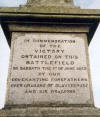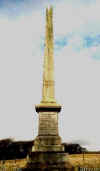|
Drumclog
1 June 1679
Drumclog
was the only occasion when the Covenanters gained a
military victory over the government forces. Modest though
the victory was, it gave them great hope.

The battle
came about when the Covenanters were assembling near
Loudon Hill in Ayrshire, for worship on the Sabbath.
Nearby John Graham of Claverhouse was pursuing the
murderers of Archbishop Sharp (3 May 1679) and had taken
some fifteen conventiclers prisoner at Hamilton including
the Rev John King, chaplain to Lord Cardross. They reached Strathaven at about six
o`clock in the morning and heard of the conventicle
assembling that day at Glaister Law or Hairlawhill
some eight miles away and about two miles from Darvel.
Swaggering and boasting of his intentions to seize the
conventiclers Claverhouse and troopers, with
prisoners in tow `tied as beasts`, came upon the meeting
on the morning of Sunday 1 June 1679 at Drumclog.
The
Covenanters held a council of war and appointed Robert
Hamilton of Prestonpans as leader, apparently because he
was the only gentleman or person of any social standing. Hamilton
had no military qualifications and his first order
displayed a lack of tact ” I, being called to
command, gave out the word that no quarter should be
given”. This was later to be the cause for executing a
prisoner who had been given quarter and illustrates the
extreme views that some held, including Hamilton who sought to
have five other prisoners executed but others were more humane. The
extremists held that failure to kill God`s enemies was weakness and
a cause of curses resting on the unhappy Kirk.
Soon, however, a watchman warned of the approach of the
troopers and the minister, the Rev. Douglas, is reputed to
have told the young armed men “ Ye have got the theory;
now for the practice.” Thus addressed the unarmed
men, women and children went to the hillside above the
chosen battle ground while the men, and some women,
marched forward singing psalms. In particular they sang
Psalm 76 `In Judah`s land God is well known` with its
menacing finish ” By Him the spirits shall be cut off.”
This same Psalm had been sung by the Rev Robert
Bruce at the Edinburgh Mercat Cross when news of the
defeat of the Armada was received in 1588. It would be
sung again by Alexander Shields and the Covenanters at
Douglas Cross at the Glorious Revolution in 1688.
On this occasion the Covenanters outnumbered Claverhouse
and his troopers by about four to one (some claim the
Covenanters totalled 1500) and they had the advantage of
knowing the ground.
 James King Hewison in The James King Hewison in The
Covenanters gives Claverhouse as having not more
than 150 soldiers. Hamilton probably had about fifty men
on horses and two hundred and fifty infantry.
Armed with mainly farm implements – scythes, cleeks,
pikes, pitchforks, and the odd fowling gun, the
Covenanters assembled at the bottom of a hill which had
marshy ground to the sides, which gave them a secure
position from which to mount their attack. Among the
Covenanter officers were some eminent names – Hackston of
Rathillet, John Balfour, Henry Hall of Haughshead, Robert
Fleming, John Loudon, John Brown, and the young William
Cleland.
Claverhouse ordered his
troopers to open fire almost as soon as they arrived but the musketry was
a mere preliminary; he wanted to get at close quarters where military
training and expertise could be brought to bear. He made his first mistake
by sending troopers into the bog to find some solid footing so that all
might come through. But the horses struggled, some riders were unseated
and musket fire also took a toll. Before the troopers realised it
Kinloch`s cavalry and the young William Cleland with his troop of infantry
were through the bog and amongst them. They were followed by the psalm
singing throng as they threaded
their way through the bogs and took on the troopers at
close quarters. The troopers lost about 36 of their number
killed and 7 taken prisoner, before they turned and fled
towards Glasgow. Amongst the troopers to fall was Cornet Robert Graham,
Corporal Crawford and a Captain Blyth. To the fore in the fighting was the
eighteen year old William Cleland of Douglas, described as
a soldier poet. He would later do great service for the
Covenanters as a Lt Colonel, leading the Cameronian Regiment at Dunkeld in 1689.
Hewison
records that Claverhouse had first offered a surrender but his
demands were spurned and he had to attack. An exchange of
fire took place and Claverhouse dismounted some of his men
to take firing positions. The Covenanters, realising that
they were out gunned, resorted to the desperate charge
by Cleland, Dingwall and

Weir on horses, accompanied by some women and fiercely
yelling men armed with pike and pitchfork. It was too much
for the troopers who could not control their horses in the
bog. Claverhouse was almost taken by William Cleland
but was let go, then had his horse`s belly slashed by a
pike or pitch fork. This stampeded his horse, which
careered off with its bowels hanging out ,and caused him
to ride away, some claim a mile, “so that his men were
cowed and fled too”. Over thirty soldiers were left
dead on the field and another twelve were killed in their
flight when the people of Strathaven tried to block their passage. They attacked the fleeing troopers in a narrow road called “Hole-Closs”. Nearby in Strathaven is “The Trumpeters Well” in which tradition has it a 14 year old trumpeter with Claverhouse`s troop was trapped and ended his life.
The Covenanters killed were few – Thomas Fleming
of Loudon; John Morton and John Gebbie of Newmilns;
Dingwall of Strathaven and William Daniel (both of them party to Archbishop Sharp`s assassination a month earlier); James Thomson of Stonehouse; and
Thomas Weir of Lesmahagow. Among the surviving Covenanters
was the valiant Sarjeant Nisbet, son of the martyr
John Nisbet of Hardhill, who was said to be personally accounted for
seven of Claverhouses` troopers.

A large
number of Covenanters gathered following the victory and
marched on Glasgow . However, poor leadership, no cannon,
and lack of direction only resulted in skirmishing and the
Covenanters withdrew without taking the city. A golden
opportunity was lost as it gave Claverhouse and the
royalist troops in Glasgow an opportunity to re-group and
to send for reinforcements. The Covenanters eventually
withdrew to the town of Hamilton where their numbers grew
to about 5000 in number. Almost inevitably factions
started arguing amongst themselves and they split into two
groups – the Indulged, and the die hard “honest” party led
by Robert Hamilton. Already the stage was being set for a
decisive battle, and a rout for the Covenanters, at
Bothwell Brig on 22 June.
Claverhouse
famously declared
“ They
pursued us so hotly, that we got no time to rally. I saved
the standards, but lost on the place about eight or ten
men, besides wounded; but the dragoons lost many more.”
The Rev.
John King and the other prisoners of Claverhouse were rescued ; King is said to have
facetiously called after the departing Claverhouse
“
will ye no` stay for the afternoon preachin` ?”.
Mauchline Moor 12 June 1648
Rullion Green 28 November 1666
Bothwell Brig 22 June 1679
Ayrs Moss 22 July 1680
|